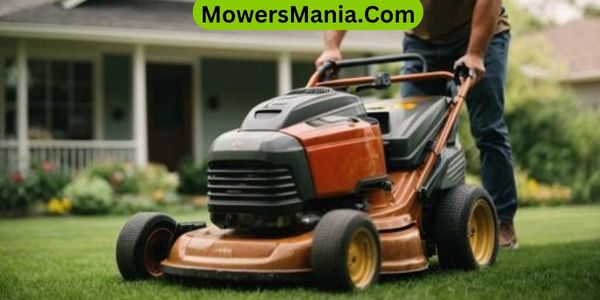If you want to keep your lawn looking pristine, you need to know how to use a lawnmower correctly and safely.
In this article, we’ll walk you through the basics of operating a lawnmower, preparing the mowing area, handling potential issues, and maintaining and storing your equipment.

By the end, you’ll feel confident and knowledgeable about making your lawn the envy of the neighborhood.
Understanding the Lawn mower Basics
When you start using a lawnmower, it’s essential to understand the basics of its operation and maintenance.
First, familiarize yourself with the controls and safety features. Before starting the mower, check the oil and fuel levels, and ensure that the blades are sharp and free of debris.
Understanding the type of fuel your lawnmower requires is crucial to its proper functioning. Most lawnmowers use unleaded gasoline with a minimum octane rating of 87, but it’s important to consult the manual to confirm the specific requirements for your machine.
Additionally, understanding the maintenance needs of your lawnmower is vital for its longevity. Regular maintenance includes cleaning or replacing the air filter, changing the oil, and sharpening the mower blades. It’s also important to inspect the spark plug and replace it if necessary.
Lastly, learning how to safely maneuver the lawnmower is crucial. Always mow in a well-lit area, away from children and pets.
Take note of any obstacles in the yard and remove them before mowing to prevent accidents. Understanding these basics will ensure that you use your lawnmower correctly and safely.
Preparing the Mowing Area
Before you start mowing, ensure that the area is clear of any debris, toys, or other obstacles that could interfere with the lawnmower’s operation. Clearing the mowing area is crucial for a safe and efficient mowing experience.
Here’s what you need to do:
- Inspect the Area: Take a few minutes to walk around the yard and carefully inspect the area. Look for any rocks, branches, or other objects that could potentially damage the lawnmower or be thrown out as projectiles while mowing.
- Remove Any Obstacles: Once you’ve identified any potential obstacles, take the time to remove them from the mowing area. This includes picking up toys, garden hoses, or any other items that could get caught in the lawnmower’s blades.
- Check for Pet Waste: If you have pets, be sure to inspect the area for any pet waste. Not only can it be unpleasant to mow over, but it can also spread bacteria and parasites. Make sure to remove any pet waste before you start mowing.
Operating the Lawn mower Safely

To mow your lawn safely and effectively, it is essential to operate the lawnmower with caution and attentiveness, ensuring that all safety features are in place and functioning properly.
Before starting the lawnmower, it’s crucial to conduct a quick inspection to ensure that the blades are sharp, the fuel levels are adequate, and all nuts and bolts are securely fastened.
Additionally, always wear appropriate personal protective equipment, such as safety goggles and sturdy closed-toe shoes, to prevent injuries from flying debris.
Operating the Lawnmower Safely
| Safety Measure | Description | Importance |
|---|---|---|
| Read the manual | Familiarize yourself with the mower’s controls | Ensures safe operation |
| Clear the mowing area | Remove any obstacles or debris | Prevents damage or injury |
| Mow in daylight | Ensure good visibility while mowing | Minimizes the risk of accidents |
Handling Potential Issues

Are you prepared to address potential issues that may arise while operating your lawnmower safely and effectively?
It’s essential to be ready to handle any problems that could occur during the mowing process.
Here are some important points to keep in mind:
- Regular Maintenance: Regularly inspect and maintain your lawnmower to ensure it’s in good working condition. Check for any loose or damaged parts, and replace them as needed. Keep the blades sharp and clean to ensure a clean cut and efficient operation.
- Safety Gear: Always wear appropriate safety gear such as goggles, closed-toe shoes, and hearing protection while operating the lawnmower. This will help protect you from any potential flying debris and loud noise.
- Emergency Response: Be prepared to handle emergencies. Keep a first aid kit and a fire extinguisher nearby. Familiarize yourself with the lawnmower’s emergency shut-off procedures in case of an unexpected situation.
Maintaining and Storing the Lawn mower
You should regularly maintain and properly store your lawnmower to ensure its longevity and efficient performance.
After each use, make sure to clean the mower’s blades and underside to remove grass clippings, dirt, and debris. This prevents buildup that can hinder the mower’s functionality.
Additionally, check the oil levels before each use and change the oil as recommended by the manufacturer to keep the engine running smoothly.
Sharpen the mower blades at least once a season to ensure clean cuts and prevent tearing of the grass.
When storing your lawnmower, it’s crucial to do so properly to avoid damage and ensure it’s ready for the next use.
Store the mower in a clean, dry area, such as a garage or shed, to prevent rust and corrosion.
Before storing, empty the fuel tank to prevent fuel from deteriorating and causing starting issues. Consider using a fuel stabilizer if storing for an extended period.
Lastly, inspect the mower for any loose or damaged parts and address them before storing to avoid further damage.
Frequently Asked Questions (FAQs)
Can I Use a Lawnmower on Wet Grass?
You shouldn’t use a lawnmower on wet grass. It can cause the grass to clump, clog the mower, and create an unsafe mowing environment. Always wait for the grass to dry before mowing.
Is It Safe to Mow the Lawn While Wearing Sandals or Flip-Flops?
Wearing sandals or flip-flops while mowing is not safe. They offer little protection and can easily get caught in the mower blades. Opt for sturdy, closed-toe shoes with good traction for safe mowing.
How Often Should I Sharpen the Lawnmower Blades?
You should sharpen the lawnmower blades at least once a year, but more frequently if you notice decreased cutting efficiency. Regular sharpening ensures a clean cut, promotes lawn health, and extends the life of your lawnmower.
Can I Use a Lawnmower to Cut Overgrown Bushes or Shrubs?
Yes, you can use a lawnmower to cut overgrown bushes or shrubs, but it’s important to ensure the mower is equipped for this task and that you’re following safety precautions to prevent accidents.
What Should I Do if the Lawnmower Starts Making a Strange Noise While in Use?
If the lawnmower starts making a strange noise while in use, immediately stop it and inspect for any visible damage or debris. Once the issue is identified, repair or replace the damaged parts accordingly before resuming mowing.
Conclusion
Now that you know the basics of using a lawnmower correctly and safely, you can confidently tackle your lawn maintenance tasks.
Remember to always prepare the mowing area, operate the lawnmower safely, handle any potential issues that may arise, and properly maintain and store your equipment.
By following these guidelines, you can ensure a well-kept lawn and a safe mowing experience.



